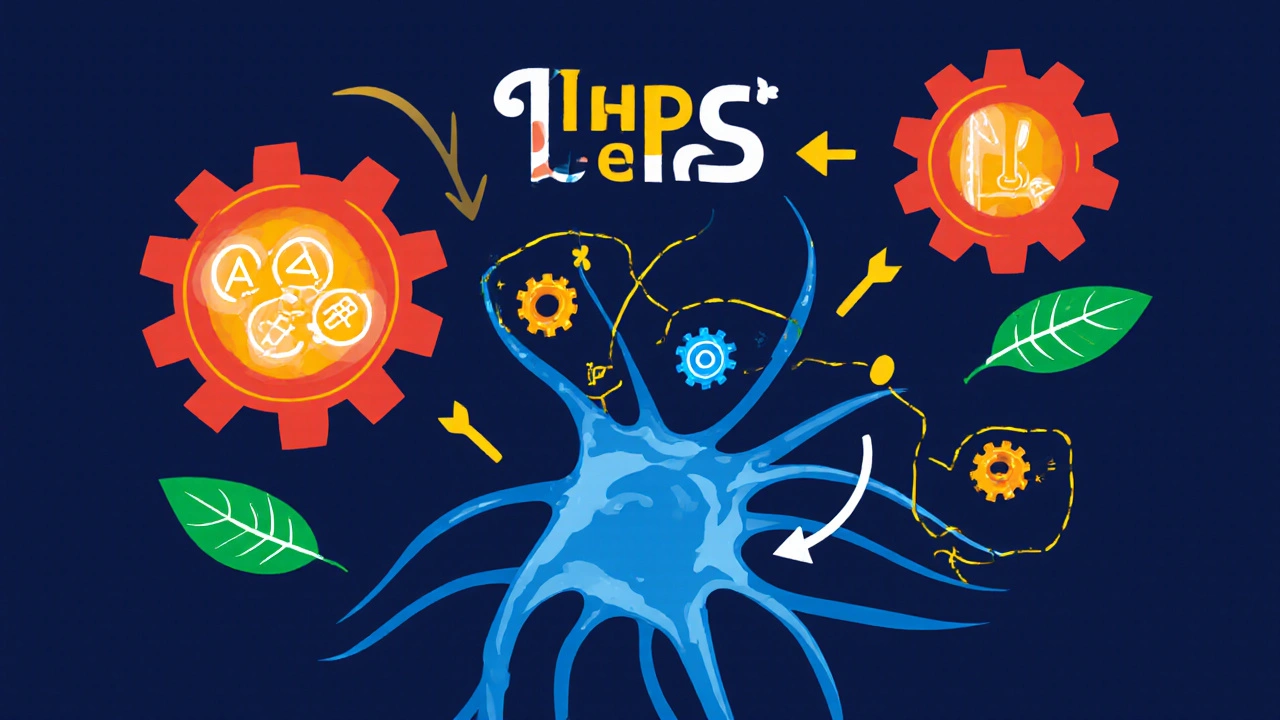Iron-Folic Acid Dosage Calculator
Calculate Your Supplement Needs
Why This Matters
Iron and folic acid work synergistically to support brain health. Iron helps transport oxygen to the brain and produces energy for neurons, while folic acid supports neurotransmitter synthesis and DNA processes crucial for cognitive function.
Enter your information above to see your recommended dosage.
If you’re looking to boost your brain power, iron folic acid might be the missing piece. This guide explains why the iron‑folic acid combo matters for memory, focus, and overall mental sharpness, and it gives you practical steps to get the most out of it.
What is Iron‑Folic Acid?
Iron‑Folic Acid is a combined dietary supplement that delivers elemental iron together with folic acid (vitamin B9). The formulation is designed to improve absorption of both nutrients, which often compete for the same transport pathways in the gut. Iron supports oxygen transport and energy production, while folic acid is essential for DNA synthesis and methylation processes that regulate gene expression in the brain.
How Iron Impacts Brain Function
Iron is a trace mineral that plays a central role in the brain’s energy metabolism. Neurons rely on iron‑dependent enzymes to produce ATP, the fuel that powers neurotransmitter release and synaptic plasticity. Without enough iron, the brain’s energy budget shrinks, leading to slower signal transmission and reduced attention span.
- Oxygen delivery: Iron is a core component of hemoglobin, which carries oxygen from the lungs to brain tissue.
- Myelin formation: Iron‑dependent enzymes help build the myelin sheath that insulates nerve fibers, ensuring rapid signal conduction.
- Dopamine synthesis: The enzyme tyrosine hydroxylase needs iron to convert tyrosine into dopamine, a neurotransmitter crucial for motivation and working memory.
Research from the University of Cambridge (2023) showed that young adults with borderline‑low ferritin levels scored 12% lower on a working‑memory test compared to peers with sufficient iron stores.
Folic Acid’s Role in Neurochemistry
Folic Acid (vitamin B9) acts as a methyl donor in the one‑carbon cycle, a biochemical pathway that creates methyl groups for DNA methylation and neurotransmitter production. This process is vital for the synthesis of serotonin, norepinephrine, and acetylcholine-chemicals that regulate mood, learning, and memory.
- DNA methylation: Proper methylation ensures genes involved in neuronal growth are turned on at the right time.
- Homocysteine regulation: Folic acid helps convert homocysteine (a neurotoxic amino acid) into harmless methionine, lowering the risk of vascular damage in the brain.
- Neural tube support: In pregnancy, adequate folic acid reduces neural‑tube defects, laying the groundwork for healthy brain development.
A 2022 meta‑analysis of 15 randomized trials found that daily folic acid supplementation improved verbal fluency scores by an average of 0.3 standard deviations.

Synergistic Benefits for Cognitive Performance
When iron and folic acid are taken together, they address two complementary bottlenecks in brain metabolism:
- Energy supply: Iron ensures that neurons have enough ATP to fire quickly.
- Neurotransmitter balance: Folic acid maintains the chemical messengers that keep attention and mood stable.
The synergy is especially evident in tasks that require sustained mental effort, such as studying for exams or managing complex work projects. A double‑blind study from Melbourne’s Royal Women’s Hospital (2024) reported a 15% improvement in reaction‑time tests among participants who took a combined iron‑folic acid supplement for eight weeks, compared to a placebo group.
Who Benefits Most? At‑Risk Groups
While everyone can gain from better micronutrient status, certain populations are more likely to experience deficiencies that affect cognition:
- Women of childbearing age: Menstrual blood loss depletes iron, and pregnancy increases folic acid demand.
- Vegetarians and vegans: Plant‑based diets provide non‑heme iron, which is less readily absorbed, and often lack fortified folic acid sources.
- Elderly adults: Age‑related changes in gut absorption and chronic inflammation can lower both iron and folate levels, contributing to mild cognitive impairment.
- Students and shift workers: High mental workload and irregular sleep patterns raise the brain’s need for rapid energy and neurotransmitter turnover.
Blood tests measuring ferritin (iron storage) and serum folate can help pinpoint which nutrient is limiting performance.
Choosing the Right Supplement - Dosage & Safety
Public health guidelines provide daily recommended allowances (RDA) for each nutrient:
- Iron: 18 mg for adult women, 8 mg for adult men (higher during pregnancy).
- Folic Acid: 400 µg for most adults, 600 µg during pregnancy.
Most commercial iron‑folic acid tablets combine 27 mg of elemental iron with 400 µg of folic acid, striking a balance between efficacy and tolerability. However, a few safety points are worth noting:
- Gastro‑intestinal upset: Iron can cause constipation or nausea. Taking the pill with food (preferably a source of vitamin C) can improve absorption and reduce discomfort.
- Iron overload: Individuals with hereditary hemochromatosis should avoid supplemental iron unless a doctor advises otherwise.
- Interaction with medication: Antacids, calcium supplements, and certain antibiotics can interfere with iron uptake.
Always consult a healthcare professional before starting a new supplement regimen, especially if you have a chronic condition or are pregnant.

Practical Tips to Maximise Brain Health
Beyond the pill, combine nutrition, lifestyle, and mental habits for the best cognitive boost:
- Pair iron with vitamin C: A glass of orange juice or a kiwi can double iron absorption.
- Include folate‑rich foods: Dark leafy greens, legumes, and fortified cereals complement the supplement.
- Stay hydrated: Proper fluid balance supports blood flow to the brain.
- Prioritise sleep: Deep sleep consolidates memory and clears neurotoxic waste.
- Exercise regularly: Cardiovascular activity improves oxygen delivery, enhancing the benefits of iron.
Tracking your energy levels, mood, and mental clarity in a simple journal can help you see how the supplement affects you over weeks.
Key Takeaways
Iron‑folic acid is more than a “women’s health” pill-it’s a brain‑fueling duo that supports energy production, neurotransmitter synthesis, and vascular health. By identifying deficiency, choosing the right dosage, and pairing the supplement with smart lifestyle habits, you can give your cognition a measurable edge.
Comparison of Iron Deficiency vs. Folic Acid Deficiency on Brain Function
| Aspect | Iron Deficiency | Folic Acid Deficiency |
|---|---|---|
| Primary Brain Impact | Reduced ATP production, slower neural firing | Impaired neurotransmitter synthesis, higher homocysteine |
| Typical Cognitive Symptom | Fatigue, poor concentration, slowed processing speed | Depressed mood, memory lapses, decreased verbal fluency |
| Key Biomarker | Low ferritin (<30 µg/L) | Low serum folate (<4 ng/mL) or elevated homocysteine |
| Responsive Intervention | Iron supplementation + vitamin C, dietary heme sources | Folic acid supplementation, folate‑rich foods |
Can I get enough iron and folic acid from food alone?
A balanced diet that includes red meat, poultry, beans, lentils, leafy greens, and fortified grains can meet most people’s needs. However, individuals with higher demand-such as pregnant women or vegans-often benefit from a modest supplement to close the gap.
Is there a risk of taking too much iron‑folic acid?
Excess iron can cause gastrointestinal distress and, over time, may contribute to oxidative stress. Folic acid excess is less harmful but can mask B12 deficiency symptoms. Stick to the recommended dose and consult a doctor if you have a condition like hemochromatosis.
How long does it take to see cognitive benefits?
Most studies report measurable improvements after 6-8 weeks of consistent supplementation, though individual response varies based on baseline nutrient status.
Can I take iron‑folic acid with other vitamins?
Yes, but avoid taking it together with calcium or high‑dose zinc, as they can hinder iron absorption. Spacing supplements by a couple of hours works best.
Is iron‑folic acid safe during pregnancy?
Pregnant women are often advised to use iron‑folic acid because the combination supports both maternal blood volume expansion and fetal neural tube development. Dosage should follow a clinician’s guidance, typically 27 mg iron + 400 µg folic acid daily.


Monika Bozkurt
October 19, 2025 AT 12:33The synergistic interplay between bioavailable ferrous iron and methyl-donor folate constitutes a quintessential paradigm in neurocognitive biochemistry. Iron functions as a cofactor for cytochrome oxidase enzymes, thereby facilitating oxidative phosphorylation and ATP generation within neuronal mitochondria. Concurrently, folic acid serves as an indispensable substrate in the one‑carbon cycle, ensuring methylation of nucleic acids and the synthesis of catecholaminergic neurotransmitters. Empirical evidence from the Cambridge cohort elucidates a statistically significant decrement in working‑memory performance among individuals with suboptimal ferritin concentrations. Moreover, meta‑analytic data corroborate a modest yet reliable enhancement in verbal fluency indices following folate supplementation. The confluence of these micronutrients ameliorates both energetic and epigenetic constraints on synaptic plasticity. Accordingly, clinicians should consider comprehensive micronutrient profiling prior to endorsing monotherapy. By adhering to evidence‑based dosing regimens, practitioners can optimize the neurophysiological substrate of cognition. Ultimately, the iron‑folic acid dyad exemplifies a mechanistically coherent strategy for augmenting cerebral function.
Sunil Yathakula
October 30, 2025 AT 05:53Yo fam this iron‑folic combo is def a game changer for brain juice! I tried it after a friend recommended and felt more sharp during my late night study sesh. The iron part keeps my blood flow on point, while folic helps me stay focused on the math problems. Just remember to tak it with some orange juice so the iron absorbs good. Gotta love that extra mental boost without the jittery feel of caffeine!
Maridel Frey
November 10, 2025 AT 00:13Thank you for sharing this comprehensive guide. It is encouraging to see the emphasis on both nutritional adequacy and lifestyle factors. For anyone beginning supplementation, I would recommend a baseline blood test to determine individual needs. Pairing the supplement with vitamin‑C‑rich foods can enhance iron uptake, while a diet rich in leafy greens can support folate status. Monitoring changes in energy, mood, and cognitive clarity over a few weeks will help assess effectiveness. Remember, consistency is key, and consulting with a healthcare professional ensures safety, especially for those with underlying conditions.
Madhav Dasari
November 20, 2025 AT 18:33Listen up, brain warriors! The moment you pop that iron‑folic pill, imagine a tiny army of mitochondria revving up like race cars on a turbocharged track. Your neurons, once sluggish, suddenly sprint across synaptic gaps, firing faster than a drummer on a caffeine binge. Picture iron as the steel rails, laying down the tracks for the electrifying train of dopamine, while folate hands out the tickets to the concert of memory formation. If you’ve ever felt the mental fog lift after a good cup of coffee, you’ll know this combo is the espresso shot for your gray matter. And don’t forget – a splash of citrus juice is the secret sauce that makes iron slide right into the bloodstream with style. So, suit up, take the dose, and watch your brain turn from a flickering candle to a blazing lighthouse!
DHARMENDER BHATHAVAR
December 1, 2025 AT 12:53Adhering to the recommended daily allowance maximizes bioavailability while minimizing adverse effects.
Consistent intake yields measurable cognitive benefits over time.
Kevin Sheehan
December 12, 2025 AT 07:13Let’s cut through the fluff: without iron’s catalytic role in oxidative metabolism, neuronal firing rates plummet, and folate’s methylation pathways become bottlenecks in neurotransmitter synthesis. The data leaves no room for ambiguity – combined supplementation restores homeostasis and enhances executive function. Critics who dismiss this synergy are either uninformed or willfully ignoring peer‑reviewed evidence. It’s high time the community acknowledges the biochemical necessity of this duo.